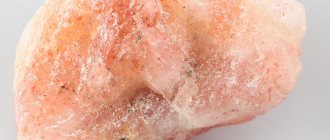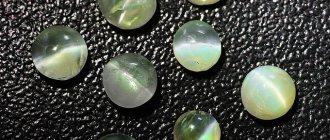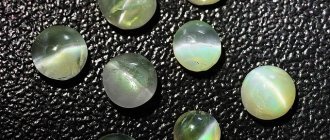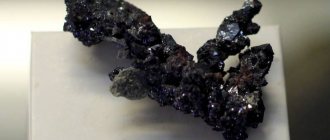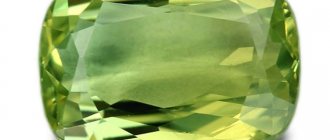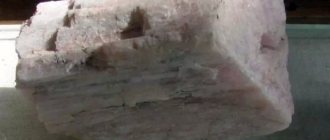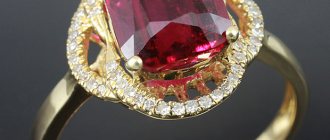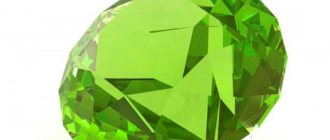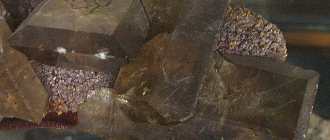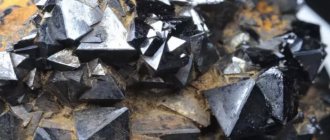| Formula | Al2O3 |
| Color | Blue and cyan in various shades; colorless, pink, orange, yellow, green, purple, black |
| Shine | Glass |
| Transparency | Transparent to opaque |
| Hardness | 9 |
| Cleavage | Absent |
| Kink | Rough to conchoidal |
| Density | 3.95 - 4.00 g/cm³ |
Place of Birth
The most famous sapphire deposits are confined to pegmatites or placers and are located in the USA, Australia, Madagascar, India, Sri Lanka, Vietnam, Burma, Thailand and China.
In Russia there are no large deposits in which sapphire can be mined on an industrial scale: its finds are confined to manifestations of blue corundum, in which transparent stones suitable for cutting are also found.
Blue sapphire is found in the Urals and on the Kola Peninsula (Khibiny). Ural sapphires, as a rule, have a grayish tint, while Kola sapphires have a peculiar greenish tint with a deep cornflower blue color.
Color
One of the main indicators of the quality of sapphires is the depth and richness of their shade. For blue stones, the reference shade is the shade of Kashmir corundum, pure cornflower blue. For fancy corundums, that is, those colored in colors other than red, there is no generally accepted standard.
To determine the color indicators of a mineral, professionals use special tables; the color is determined visually, without the use of instruments. This characteristic of sapphire has three components: tone, saturation and lightness. Interestingly, the last parameter is valued differently in different countries. Thus, dark corundums are more popular in Russia, while light corundums are more popular in Europe.
There are five categories of lightness and three of saturation; shades are usually divided according to the spectrum, but to simplify the classification in commerce, three names are used: bright (1), medium (2) and light (3) blue.
Color varieties
Blue sapphire
Blue sapphire
Thanks to its amazing shades, it is the most valuable variety. Its color and color saturation depend on the presence of titanium and iron impurities.
The shade of blue sapphire can be light, almost colorless, or it can be so deep that the stone appears almost opaque.
Such dark sapphires are less valuable. Due to the presence of various impurities, pure and uniform color is quite rare.
But when cut correctly, blue sapphire becomes a real treasure. Sapphires of a special cornflower blue color were found in Kashmir. They can cost more than emerald.
Yellow sapphire
Yellow sapphire
The stone can be of different shades from light yellow to deep amber. Its popularity is slightly less high than that of blue, and the pure color is also quite rare.
Yellows are generally cheaper than blues, but are also widely used in jewelry due to their pleasant warm hue.
Green sapphire
Green Sapphire
The stone does not have such a pure green hue as emerald. Its color is formed by the fusion of yellow and blue areas.
It is valued lower than other types of sapphire. Stones of a greenish hue can be found in the mountains of the Kola Peninsula.
Pink sapphire
Pink sapphire
Rarely found, mainly in deposits of Madagascar and Sri Lanka. It has an amazing delicate shade and successfully replaces a more expensive pink diamond.
White sapphire
White sapphire
The second name is leucosapphire. An absolutely transparent stone, very similar to a diamond. Due to its lower cost, it is sometimes used as a replacement. Interesting effects are achieved in jewelry by combining these stones with each other.
Black sapphire
Black sapphire
An opaque or translucent stone with a noble shine, reminiscent of agate.
The stone is not valued very highly; it is suitable for creating jewelry in a simple style, in jewelry for men. Mainly mined in Australia. Black star sapphires are of particular value.
Star sapphire
Star Sapphire
Star sapphires, sometimes called star stones, have needle-like rutile inclusions in their structure that refract light in a special way.
When properly polished, the light on their surface is refracted in the form of a star-shaped figure. To achieve this effect, the surface of the stone is not cut, but polished, giving it the shape of a sphere or hemisphere.
The price of such crystals depends on their shade and quality of light reflection.
Product marking
It is difficult for a non-specialist to determine at first and even at second glance what kind of stone he is holding in his hands. Therefore, each stone or jewelry decorated with corundums has a certificate indicating all the characteristics of the sapphire. For jewelry, this is usually a tag attached to the item. To read it correctly, you need to know what the letter abbreviations and numbers indicated on the tag mean.
Usually the inscription looks something like this: 1C Kr. 2×3 0.22 1/2. The numbers are taken as an example so that you can clearly see the meaning of each indicator.
- 1C – number of stones and their name. In this case, one sapphire.
- Kr. - a cutting method, the letters will change depending on the shape that the stone was given.
- 2x3 – size.
- 0.22 – carat weight.
- 1/2 – indicators of the color and purity of the stone.
Please note that for stones processed abroad, a letter designation of purity will be indicated: VVS, VS, SI, I. They mean the same thing as the domestic digital system, in the same order.
In any case, to insure yourself against counterfeiting, it is better to purchase sapphires from trusted stores. Modern technologies make it possible to produce elements so similar to natural ones that only a professional can distinguish them.
Synthetic sapphires
Synthetic sapphires
Today, sapphire is in demand in technology and jewelry. First of all, this concerns optically transparent sapphire - leucosapphire. Due to its outstanding hardness and heat resistance, it is widely used as wear-resistant and heat-resistant windows, such as in a variety of mobile gadgets: wristwatches, cell phones.
Sapphire substrates are also used in the semiconductor industry in the manufacture of semiconductor chips and LEDs using silicon-on-insulator technology.
Artificial sapphires were first synthesized in 1904 by French chemist Auguste Verneuil. The synthesis method he used - droplet deposition in an oxygen-hydrogen flame - is now called the Verneuil method. Today this method is also used for the industrial synthesis of sapphires.
Later, the Czochralski method and its variations (Kyropoulos method, Stepanov method) were invented - pulling a crystal from the melt using a seed crystal. Today, this method produces sapphires weighing up to 300 kilograms.
The world produces hundreds of tons of synthetic sapphires per year, mainly in China, Japan, the USA and Russia. One of the world's largest enterprises for the synthesis of sapphires operates in Russia.
The resulting sapphires are cut and polished with diamond tools to the customer's size.
Main uses of artificial sapphires:
- Jewelry making.
- Optics resistant to impact, abrasion, temperature, ionizing and ultraviolet radiation. Including glass for gadgets, armored glass for military equipment.
- Substrates for semiconductor chips using silicon on sapphire technology.
- Substrates for optoelectronic devices based on gallium nitride (GaN). This process is also used to produce blue LEDs, which are used to make white LED lighting.
- Additive-activated working fluid for solid-state lasers.
The magical properties of sapphire
Ring with black sapphire
Sapphire has the ability to accumulate cosmic energy.
It helps to find harmony and integrity in life. It is of particular importance for those who want to find their way, find inner comfort, and get rid of depression.
For a person who is too prone to unnecessary rushing, sapphire will be an excellent assistant in establishing internal balance.
It fuels creativity and brings inspiration. The protective properties of sapphire are widely known.
It cleanses space from any negative energy, so its wearer is not subject to the evil eye and damage. The pure color of sapphire symbolizes the honesty, fidelity, and chastity of a woman.
The stone is used to make amulets against the evil eye and talismans, symbolizing the radiance of the mind, spiritual purity and wisdom.
The magic of sapphire depends on its color:
- Yellow is a particularly strong protection against damage, the evil eye, slander, as well as internal uncertainty and anxiety. Gives determination, attracts creative ideas, relieves depression. Anxious people are not recommended to wear this stone constantly, because... it can lead to inner restlessness.
- Blue is the best talisman for those who have problems with the cardiovascular system. Relieves inflammation and headaches. Allows you to collect your thoughts and tune in to a positive wave. Designed for those who want to always achieve their goals.
- Light blue helps you feel the energy of higher powers and reveal magical abilities.
- Black is the best talisman that prevents depression, can restore taste and interest in life, and restores self-confidence. It is a good talisman against dark forces.
- White sapphire allows you to regain faith in yourself, show your inner potential and achieve success. This is a symbol of fidelity and purity, which can be a good gift as a sign of your feelings for your loved one.
- Green helps with sleep problems, develops kindness, compassion, and empathy in people. Helps with eye diseases.
- Pink sapphire – you need to be careful with this stone, because... it helps to materialize thoughts. If you keep a thirst for profit in your soul, anger, envy, dark thoughts can materialize and hit the bearer of this stone. But if your thoughts are bright and your goal is noble, pink sapphire will definitely help you realize it.
Star sapphire has special magical powers, which accumulate energy at the intersection of light rays.
It must be remembered that any sapphire with color defects can lead to the opposite effect, bringing suffering and trouble to a person.
Characteristics
Now all corundums are called sapphires, with the exception of those that are red in color (rubies). From a chemical point of view, the description of the stone is as follows: sapphire is a mineral consisting almost entirely of aluminum oxide. It has a glassy luster and one of the highest strength values on the Mohs scale (the table indicates a number of 9 points). Only diamond is considered a harder mineral. The clarity and purity of sapphire can vary. There are both transparent stones, varying in purity, and completely opaque gems.
Some corundums are characterized by the phenomenon of asterism - the appearance on the surface of a stone of a star with six or twelve rays. This feature occurs in minerals with rutile inclusions, using a cutting method called “cabochon”. Star sapphires are more expensive than others.
Healing properties
Raw sapphire Madagascar
People wearing a pendant inlaid with sapphire on their chest do not have to worry about the condition of the heart and blood vessels. The stone also has a positive effect on the endocrine system.
But not only does the blue crystal affect the heart and metabolism, it helps in the treatment of insomnia and mental disorders. In order for the gem to relieve sleep disturbances and nightmares, it should be placed under the pillow before bed.
But mainly the mineral affects the mental state of a person. It increases his intellectual abilities. Gives the owner a thirst for life, teaches him to cope with neuroses and depression.
And sapphire is the stone of those people who live long. It protects the owner from brain diseases, helps maintain clarity of mind until old age and live a long and happy life.
Modern medicine casts doubt on the ability of minerals to treat certain diseases, but the experience of our ancestors proves the opposite.
Jewelry inlaid with sapphires is chosen to last forever. They become a family heirloom and are passed on from generation to generation. Products such as good wine become more and more expensive every year.
Areas of application
Ring with star sapphire
The main use of sapphire is jewelry. In addition, there are other areas of application of the mineral. It depends on the appearance and purity of the gem. Sapphire purity is a characteristic that reflects the transparency of the mineral on a scale from 1 to 4:
- 1 – transparent, tiny inclusions do not deteriorate the appearance;
- 2 – transparent, the color is saturated, the defects are larger, but not visible under a magnifying glass;
- 3 – opaque, inclusions visible to the naked eye;
- 4 – slightly transparent, cloudy, indefinite color, many defects.
Transparent and translucent minerals go to jewelers. Lower quality and lab grown stones, especially clear ones, are used in the technical industry. They are made from:
- parts in ophthalmic instruments;
- substrates for microcircuits;
- glass for airplanes, helicopters, rockets;
- glass slides;
- inserts in cameras;
- glasses for gadgets, watches.
Mineral mining sites
The largest share of sapphire production comes from deposits in Australia. But most of the minerals mined in this country are of poor quality and value. The most expensive stones are those mined in the Indian states of Kashmir and Jammu. They are distinguished by their excellent cornflower blue hue, which can decorate any piece of jewelry. The high price of Indian sapphire is due to small mining volumes. After all, stone deposits are located high in the mountains, and collection occurs manually.
Average quality stones are found in Thailand, but deposits have dried up over the last century. In the gem market, instead of Thai sapphires, Cambodian sapphires of the same quality are presented. Deposits of stones of various colors are scattered all over the world, but only in Tanzania can you find specimens that can change color. Stones mined in Russia are not of particular value due to the lack of characteristic transparency and brilliance. Back to contents
Jewelry with sapphire
Products with precious sapphire inserts have been highly valued at all times. Today, leading jewelry houses use corundum both in individual products and in entire collections. Sapphires with step or diamond cuts, as well as “star” stones with cabochon cuts, look especially elegant. When combined with topazes, amethysts and emeralds, blue sapphires acquire new colors.
The classic combination of sapphires and diamonds, which has become a symbol of luxury, is still relevant. Blue sapphires always look spectacular when set in white or yellow gold. At the same time, complemented by a combination frame, the classic duo of precious stones sounds fashionable and modern.
The trend is for models with “fantasy” sapphires in delicate shades, which give the products a special sophistication. The combination of many bright “fantasy” stones in one piece allows you to bring to life the most daring design ideas.
A piece with sapphires is not only a stylish addition to any look, but also an indicator of impeccable taste. Kate Middleton, Penelope Cruz, Carrie Underwood, Heidi Klum, Jessica Simpson, Katie Holmes and others shine in jewelry with these precious stones.
A cut that reveals the soul of a stone
In their natural form, without cutting, sapphires do not look nearly as impressive as we are used to. Only processing allows us to reveal the beauty of the mineral, to let rays of light into its transparent blue depths, so that it reveals its magical shine and appears before us in all its glory. The jeweler chooses the cutting method in such a way as to remove or make the largest defects invisible.
For translucent stones of the third and fourth categories, as a rule, a cabochon cut is chosen, i.e. give the surface of the stone smooth rounded outlines without edges. The same treatment is considered most effective for star sapphires, in the center of which a bright six-rayed star is visible. Sometimes a star has 12 rays. This original effect is given to the mineral by inclusions of needle-shaped crystalline rutile, which significantly increases the cost of the stone.
For transparent sapphires, a conventional faceted cut is performed, and the shape, number and arrangement of facets depend on the initial qualities of the crystal and its purpose. A cut sapphire can be oval, round, pear-shaped, teardrop-shaped, rectangular, triangular, etc. After cutting, the stone takes on the appearance of a real jewel, its shine and play of edges.
How much does sapphire cost?
Earrings with sapphire and diamonds
The cost of sapphire is influenced by color. Next, the location of extraction, purity/transparency, and weight are taken into account. It is being clarified whether it has been ennobled.
The most expensive is the blue stone. It is assessed by location and weight.
Prices for “Burmese” sapphires:
- 1-3 carats - 3.8-9.4 thousand dollars per carat;
- 4–10 carats – 9.7–17 thousand dollars per carat;
- from 11 carats - 18–27 thousand dollars per carat.
The cost of other stones is determined by weight (thousand dollars per 1 carat):
- padparadscha - from 2.4, a large specimen (larger than 5 carats) is considered a collectible, costs from 31 thousand dollars per carat;
- pink - 0.9–6.5;
- yellow - 0.7–3.6;
- star blue - 0.7–3.4;
- orange, purple, alexandrite - 1100–2200;
- colorless - 0.2–0.4;
- green - from 0.06;
- black - 0.003–0.01;
- star black - 0.05.
Substandard stones are valued not by carats, but per stone - $10–20.
Beware: doublets
Gluing together minerals of different quality or natural sapphire and fakes is rare, but this method of simulating a more expensive stone is still quite possible. If the frame of the gem hides its bottom, then recognizing the doublet is very, very difficult. However, an ultraviolet lamp can come to the rescue here. After all, even if different parts of the stone do not glow differently or do not glow at all, the glue that connects them will certainly begin to fluoresce. Sapphire is the second hardest mineral after diamond. Therefore, its edges must be perfectly smooth. If you notice any chips or irregularities, it is unlikely that this is a real sapphire.
How to recognize a fake
Glass imitations are usually sold under the guise of sapphire. Artificial gems are not fake; they meet all the chemical, physical and external characteristics of natural stones. A sign of a laboratory mineral is that there is a growth zone (a stripe of a more saturated color inside the gem).
Here's how you can tell a real sapphire from an imitation one at home:
- Natural stones contain inclusions in the form of dots and dashes, this can be seen through a magnifying glass. Artificial specimens do not have them, but they are much more expensive than glass fakes.
- The gem is very hard and resistant to external influences. If you run it across the glass, it will leave a scratch on the glass.
- Sapphire is cool. Glass heats up faster in the palms.
Which zodiac sign suits sapphire as a talisman?
When choosing a stone, you need to evaluate your compatibility with it according to your horoscope.
In fact, sapphire suits many zodiac signs. It is important to consider the following:
- Stones give Aries wisdom and style. Sapphire also provides protection from enemies.
- Taurus people can become more self-confident with the help of sapphire.
- For Gemini, the stone will help make life more interesting and eventful.
- Cancers will be able to improve their health with the help of the stone.
- Leos who wear the stone will noticeably increase their productivity at work.
- For Virgos, the gem will help them establish contacts with colleagues.
- For Libra, the crystal will help develop intuition and make them more purposeful.
- For Scorpios, the stone will relieve thoughts of the past.
- For Aquarians, the gem will help them think soberly in difficult situations.
- The crystal will give Pisces success in any business.
- Sapphire will make Sagittarius more active.
Sapphire is strictly contraindicated for Capricorns. The stone will strengthen all the negative qualities of representatives of this sign - laziness, rancor, pride.
The stone suits almost all zodiac signs, except Capricorns.
Sapphire is a unique stone that has a charming appearance and is often used to create spectacular jewelry. In addition, the gem has pronounced healing and magical properties. In order for these characteristics to be fully revealed, it is important to choose the right shade of the crystal and follow the rules for wearing it.
How to care for stone
Many jewelry owners have experienced the frustration of having their favorite pieces damaged. Some stones have very low strength and split from a slight blow, others do not tolerate contact with chemicals.
As for sapphire, it is more durable. Its hardness is 9 out of 10 on the mineralogical scale, so sapphire jewelry does not need to be stored in a separate padded box. Wash them with soap every few months and then leave them to dry naturally. In summer, it is recommended to repeat this procedure somewhat more often.
Cleaning jewelry with soap is different from regular hand washing. Jewelry should not be rubbed against soap, otherwise its particles will become clogged with uneven surfaces and will then be difficult to wash. Use soapy water for cleaning. To make it, lather the soap in a plate or cup.
Description of the sapphire stone and its characteristics
Sapphire is a mineral whose starting material is corundum. It is aluminum oxide. To form natural crystals under natural conditions, a high alumina content and a minimal amount of silica are required. The stone should not be confused with sapphirine, which got its name due to its resemblance to sapphire, but belongs to a completely different category.
The formation of crystals and their obtaining of one or another shade is associated with the presence of impurities:
- To get a blue stone you need titanium,
- yellow contains iron oxide,
- and pink contains manganese.
In total, there are about 2 thousand shades of such stones.
Even a rare green sapphire can change its shade under the influence of X-rays or changes in temperature. In this case, colorless crystals can be colored under the influence of x-rays.
When the stone is heated, its shade becomes less intense. For example, pink crystals can be obtained by heating a purple stone, while yellow crystals will then become colorless.
According to the description, the key characteristic of the mineral is the correct crystal structure and double refraction. In terms of hardness, sapphire is second only to diamond.
There are sapphires of different colors.
Answering the question, what is sapphire, you need to outline its properties:
- chemical formula - Al2O3;
- glass shine;
- various colors;
- density - 4.0 g/cm3;
- hardness according to the Mohs scale - 9 points;
- lack of fragility;
- conchoidal fracture.
How to wear it correctly
Products with small sapphires can be worn in everyday life, but large stones are best left for special occasions. Owners of jewelry with such a gem need to consider several factors:
- deep blue stones are better suited for brunettes and older women;
- blondes and young girls harmonize well with light jewelry;
- for the office or everyday activities, it is better to choose modest jewelry; the frame can be silver or white gold;
- dark stones in massive rings and cufflinks are well suited for business men.
It is better to buy sapphires on the 8th lunar day. After purchasing, the jewelry should not be worn immediately. It is better to wait until 22 lunar days.
Stone analogues
Not only sapphire, but also many other natural gems have a blue color in nature. The following can be passed off as noble corundum:
- cordierite (“water sapphire”);
Water sapphire - kyanite;
Blue kyanite stones - blue tourmaline;
Blue tourmaline - tanzanite;
Tanzanite - blue noble spinel.
Blue noble spinel
There are even more analogues of low-quality yachts - cloudy, opaque. Blue glass is also common among fakes.
What stones does it go with?
Ring with sapphire
Sapphire loves to be the soloist in jewelry on her own, without the need for neighbors. This precious mineral absolutely does not tolerate the proximity of Earth stones (opaque minerals), since they are often too cheap.
Sapphire does not combine with beryl or malachite. This applies to proximity not only in the product, but in the image as a whole.
It is not recommended to wear sapphires with pearls - these minerals conflict both stylistically and energetically.
The best combination is considered to be a tandem with ruby, diamond, garnet, cubic zirconia and amethyst.
